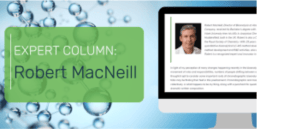UHPLC–MS: ultra highly-petrifying literature creeps me speechless

In this year’s Halloween special, Robert MacNeill (Bristol Myers Squibb; NJ, USA) delves into some chilling bioanalytical horrors…
 Robert MacNeill received his Bachelor’s degree with Honors in Chemistry from Heriot Watt University then his MSc in Analytical Chemistry from the University of Huddersfield, both in the United Kingdom. Robert is also a Chartered Chemist and a Fellow of the Royal Society of Chemistry. With almost 30 years of experience in all aspects of quantitative bioanalytical LC–MS/MS method development, a regular speaker, patent-holder and contributor to the scientific literature, Robert is a recognized expert and innovator in the field.
Robert MacNeill received his Bachelor’s degree with Honors in Chemistry from Heriot Watt University then his MSc in Analytical Chemistry from the University of Huddersfield, both in the United Kingdom. Robert is also a Chartered Chemist and a Fellow of the Royal Society of Chemistry. With almost 30 years of experience in all aspects of quantitative bioanalytical LC–MS/MS method development, a regular speaker, patent-holder and contributor to the scientific literature, Robert is a recognized expert and innovator in the field.
In his current role, after spending over two decades in bioanalytical contract research, Robert is a scientific director at Bristol Myers Squibb, within regulated bioanalysis. Here, he continues to give mentorship in LC–MS/MS method development and validation, works to foster innovation and enjoys technical and witty writing.
Clad in his long white coat, he hunched against the howling winds mercilessly sweeping across the moor. His eyes painfully made out the three figures in the distance just as the last embers of the sun fell back into the darkening sky, another deep violet night setting in. Through the winds, the broken peals of laughter in the distance felt like icy waves washing against his very soul, rocking him repeatedly off balance as he trudged forward through the deep and unforgiving heather. Suddenly, he caught a hint in the air of the rank odor coming from the cauldron that the screeching figures were keenly huddled around, vigorously stirring with inhuman movements and utterly sinister intent. He retched, picking himself up in a final monumental effort and, bristling with determination while he felt his heart still somehow intact, staggered the remaining distance to face the cackling trinity of terror.
“I hope you’re not trying to visually suggest that only n=3 will give sufficient grounds for a precision measurement pertaining to whatever you asked me to measure in there,” he yelled at the now-silenced, gawping faces.
Halloween. That sinister, spine-chilling and categorically insalubrious time of year when we are most plagued by matters that we cannot begin to explain. Out in the long shadows of twilight, we might slowly lift our weary heads toward the imposing skies and gaze longingly into the unending distance, pondering the indescribable vastness and meaning of what lies beyond. We might haul our bodies to the icy, jagged, wind-blown summits of long-forgotten and unforgiving mountains, perishing in treacherous, unspeakable conditions, all in the name of experience and even enlightenment. We may even, at times, be entirely unreceptive to a toddler’s polite request for another strawberry ice lolly, only to swiftly discover in the next few ear-splitting and soul-crushing moments that we are indeed forever a mere hair’s breadth from the abyss.
While the mysteries abound, may we for a cold moment ponder what is the real Dracula’s castle, the thunderous, amped-up Frankenstein’s laboratory, the nightmarish haunted house isolated deep in the untouched forests in the back of beyond, the apex of all that is awful? Or perhaps a ghastly collection of horrors, enough to make our column collections stand on end? Let’s try to take our hands away from our eyes and tread carefully through some creaky corridors of baleful bioanalysis…
A first sharp intake of breath; the sight of mass-to-charge ratio so often shown accursedly in units of Daltons, not Thomsons. The Dalton is the unit of mass, to be used with the likes of isotope-averaged molecular weights, not appropriate to the nature and charge-dependent dynamics of mass spectrometric detection, where we see m/z and deal with exact measurements.
Then, the concept of using an analytical column as a filter with zero analyte retention, perhaps? To have elution beyond the void is fundamental for functional chromatography. At least three void times, in fact, is the recommendation. Otherwise a host of methodological mayhem could be in store as we ditheringly dispense with resolving power and selectivity.
 Read more columns from Rob MacNeill here, including:
Read more columns from Rob MacNeill here, including:
In the same nefarious note of selectivity, how about the harrowing handicap of being restricted to produce a top-notch method featuring only the instrument-fouling, selectivity-starved protein precipitation? Wonderfully useful as a technique over the history of bioanalytical LC–MS, of course, but wouldn’t want to be nailed into a nightmare where no more potent extractive option was at hand, especially for the known high-bar of biologics.
Stutteringly speaking of extractions, it scares me somewhat that recovery calculations are taking a back seat of late. This is performed in method development, naturally, but I would opine that a method validation should by no means gloss over this key method performance characteristic. Quite simply, poor recoveries are a danger sign for long and short-term method performance and reliability. The lower the recovery, the more variable it will innately be, a Jekyll & Hyde-like recipe at best, not to mention missing room for more sensitivity.
Another fearful foe of my personal ideal workflows is the routine of preparing and extracting samples in exactly the same sequence as the final order of analysis. This seems undoubtedly aligned with making one’s life difficult, creating more chance of preparative mishaps in addition to removing a great way to diagnose a problem if the overall analysis ends up going awry.
There’s also the perilous prospect of having to “detune” multiple mass spectral transmission parameters when other options like extent of extract dilutions and injection volume minimization are exhausted. Dangerous in aspects such as selecting a lens voltage or offset where a shift off-optimal is unlikely to bring unwelcome imprecision to an assay alongside the intended reduction in signal.
More heart-in-mouth scares might include giving a formic acid in methanol solution more than a single-day useful lifetime, since it’s a reactive mixture, or keeping a pH-neutral-ish buffer solution of a common 10-25 mM ionic strength just a few days ambient relaxation until the all too visible clouds of microbes are falling over themselves to destroy a system or assay.
Let’s now wrap all of this up like an ancient Egyptian mummy, before it inevitably becomes horrifically re-animated and shambles slowly but relentlessly in our direction. Until next year, perhaps… and I haven’t even mentioned that silent, shadowy, looming figure of non-specific adsorption…
As a final note, each terrible topic mentioned here is covered in far more devilish detail in previous pointy-toothed pieces.
As the readership, what have been your bioanalytical banes? I would love to hear.

Disclaimer: the opinions expressed are solely that of the author and do not express the views or opinions of their employers, Bioanalysis Zone or Taylor & Francis Group.
Our expert opinion collection provides you with in-depth articles written by authors from across the field of bioanalysis. Our expert opinions are perfect for those wanting a comprehensive, written review of a topic or looking for perspective pieces from our regular contributors.
See an article that catches your eye? Read any of our Expert Opinions for free.


